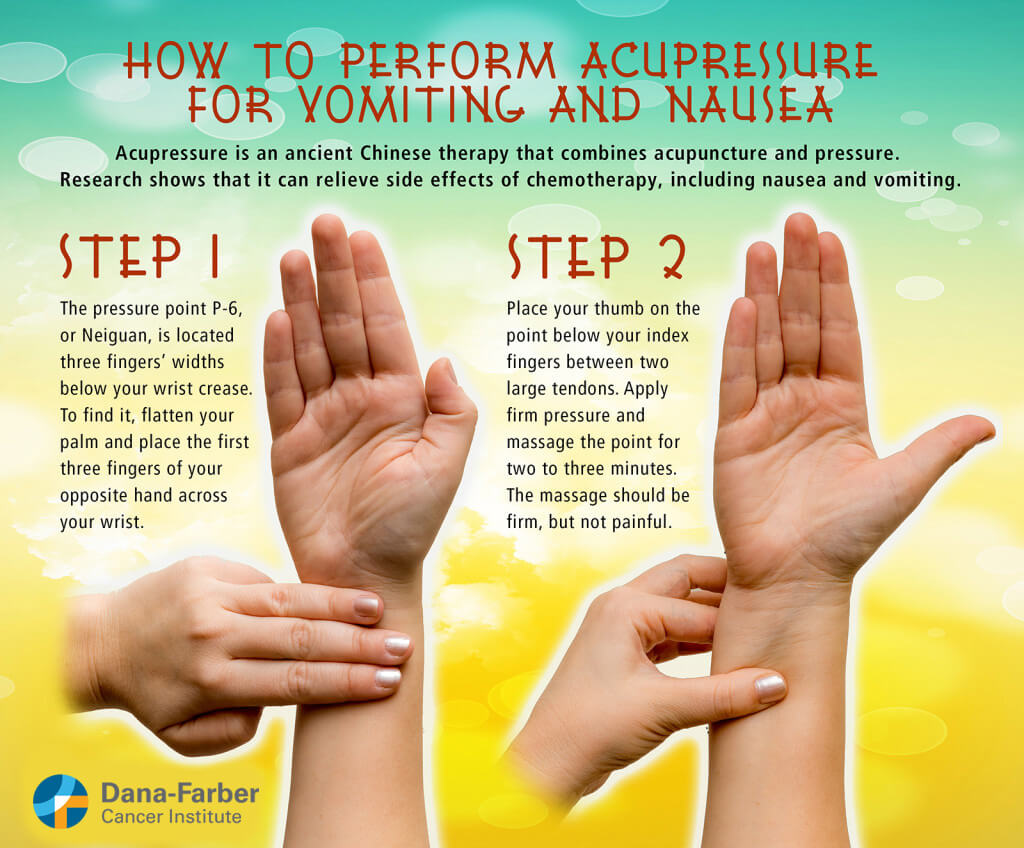Chemotherapy and radiation are successful in treating many types of cancer, but these treatments can also cause side effects such as vomiting and nausea. A form of ancient Chinese therapy called acupressure, similar to acupuncture, has been shown to help alleviate these side effects.
While acupuncture uses needles to stimulate pressure points to help with certain symptoms, and is always done by a professional, acupressure only requires the use of one’s hands and can be done on one’s own. Both techniques have been practiced for thousands of years.
“Acupressure is like acupuncture’s sibling,” says Weidong Lu, PhD, Lic.Ac., lead oncology acupuncturist at Dana-Farber’s Leonard P. Zakim Center for Integrative Therapies and Healthy Living, which offers acupuncture for patients at Dana-Farber as part of its services.
Learn how you can experience these benefits at home by massaging certain pressure points in your wrist.

Step 1
The pressure point P-6, or Neiguan, is located three fingers’ widths below your wrist crease. To find it, flatten your palm and place the first three fingers of your opposite hand across your wrist.
Step 2
Place your thumb on the point below your index fingers between two large tendons. Apply firm pressure and massage the point for two to three minutes. The massage should be firm, but not painful.
How does acupressure work? What are the benefits?
The traditional Chinese theory of acupressure suggests that symptoms like nausea are caused by a blockage that inhibits the body’s “energy” from flowing properly. Applying pressure to certain points alleviates this, the theory suggests.
“By stimulating these acupressure points, it was believed that you were stimulating a life-energy to restore a natural balance,” Lu says.
Today, research suggests that patients see benefits of acupuncture and acupressure. A study published in 2007, for example, surveyed over 160 women who were on chemotherapy for breast cancer. One group used acupressure on the P-6 point; another was taught a placebo technique using an acupressure point that wasn’t associated with nausea; another group was given typical care. The researchers found that while patients experiencing acute symptoms did not feel a difference, those with delayed nausea (on the second day and onward of treatment) had a statistically significant reduction in intensity when they used acupressure on the P-6 point.
“The application of acupressure varies from patient to patient,” explains Lu. “Some that are experiencing severe symptoms will require medication, but they can use this method in conjunction with those medications.”
Acupressure can be beneficial for patients that do not want to add anti-nausea medications to their regimen and are experiencing mild symptoms, Lu notes.
“The drugs for nausea target acute symptoms,” says Lu. “For patients that have delayed symptoms, that experience them several days after receiving chemotherapy, these interventions can help.”
Patients have also reported additional benefits of acupressure and acupuncture, including a reduction in anxiety, stress, and pain, Lu notes. You can try:
- Applying pressure to the point between your eyebrows, which is commonly used for anxiety.
- Massaging the ears, which can help with nausea.
- Massaging the top of your head, which can help with stress.
